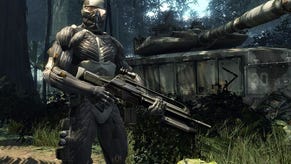Crysis 3 review
Prophet or loss?
Read the landscape, make a plan, see what happens when it's set in motion across huge, open environments: these three beats embody the dark island spirit that marked the original Crysis out from other, almost-as-pretty shooters. Despite the glitz and spectacle, this sort of thing often felt like a distant memory when playing Crysis 2. Behind the alien invasions and mysterious Nanosuits, Prophet's most recent battle against the Ceph was telling a more interesting story of how technology can affect the kind of places games can take you to, and how those places, in turn, can affect the kind of fun you have.
It wasn't a particularly happy narrative. Tailoring the tech for consoles as well as PCs meant compromise, and Crysis 2's compact urban spaces struggled to give you the same tactical freedom as the first game. Forget taking in a massive vista and formulating a strategy - how were you even meant to find your way out of this claustrophobic alleyway and towards the "action bubble" that lurked up ahead?
Crysis 3 is an attempt at synthesis. 20 years after the events of Crysis 2, what's left of Manhattan has been stuck under a mysterious high-technology dome designed by the evil Cell network in a bid to contain the last of the alien menace and control the planet. The dome has conveniently done just the things many players will want it to have done: it's jumbled the architecture of the city, opening out the famous avenues and flattening fresh plains where knee-high grass can take root, and created a series of playgrounds for sadists who like to mess with their enemies before killing them. Part nature preserve, part oilrig, this is the environment that Prophet and his Nanosuit are dropped back into after being freed from Cell captivity.
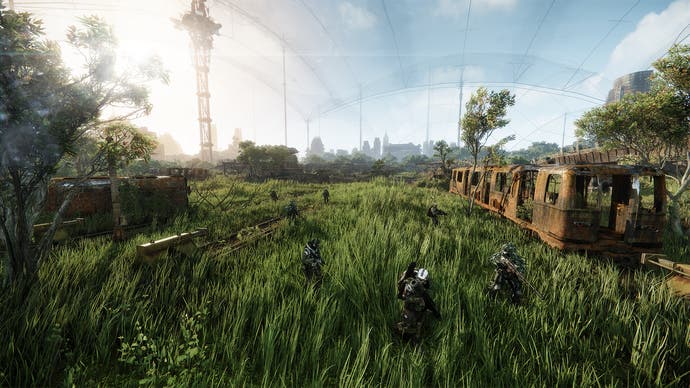
A lot of the time, it works. Early on in Crysis 3 I venture into the shattered Financial District and run up against a deer gadding about by a brook. Animal cameos? This is a good sign - as is the fact that the Cell troops hacking through the undergrowth behind the deer are starting to freak out. "We're being hunted!" one of them says, encountering the body of an unfortunate team member I crossed paths with moments earlier. "He's using a bow."
Ah, the bow. Take it as read that Crysis is a shameless Rambo simulator of almost self-parodying intensity, and the bow becomes an excellent toy. With its silent one-hit kills and its ability to be fired while you're still cloaked, it's also the key to understanding which part of the series' DNA Crysis 3 has focused on. Play Crytek's latest as a sinewy sort of stealth game - lurk in the long grass, waiting for your moment - and you'll have a lot of fun.
The AI remains a bit patchy but the flesh-and-blood forces you're up against are still fun to panic and pick away at, while the lumpen aliens are joined by new varieties. They're a little more feral in both visual design and aggressive tendencies, and the bigger ones come with palate-cleansing heavy weapons that can be wrenched off and used for a bracingly explosive change of tack.
Crysis is a shameless Rambo simulator of almost self-parodying intensity
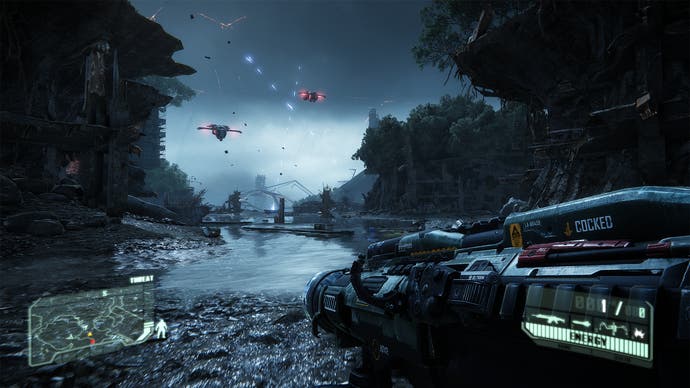
At times, Crytek's built an admirable museum of sadism, filled with colourful maps that you traverse in sudden bursts of violent - often silent - action, set amidst tense periods of waiting. Your Nanosuit sets the pace, with its streamlined choice of the invisibility of cloaked stealth or the near-invincibility of boosted armour encouraging moments of both heroism and foolish risk-taking. That bow, with its glorious creaking sound effects and its ever-dwindling supply of arrows, provides the highlights.
It's freedom within restrictions, then, and while the smaller level sizes may annoy fans of Crysis and Crysis Warhead, the linearity of Crysis 2 has been more skilfully hidden. In fact, many of the game's limitations are energising. Your suit power trickles away slowly if you're standing still but diminishes much faster if you're moving or under fire, for example, and that builds a pleasant tension whenever you lean out from safety. Elsewhere, constant ammo shortages enforce a kind of creative thrift. Fell enemies only where you'll be able to pluck the bodies from their arrows afterwards, and never enter a fight until you've marked all nearby weapon caches on your tactical visor.
The game's best moments throw you up against a human squad or two in surroundings that are both daringly exposed and filled with intricacy: a train yard where your foes have control of the gantries but are struggling to hold onto a network of waterlogged tunnels running beneath the tracks; a stretch of downtown turned into a wild savannah. Meanwhile, extracurricular objectives usually mean upgrade points for your Nanosuit. If you can pick off a few more baddies and venture away from the main waypoint marker, you'll probably be able to buy a perk that allows you to stay cloaked longer, say, or move quicker. Handy stuff.
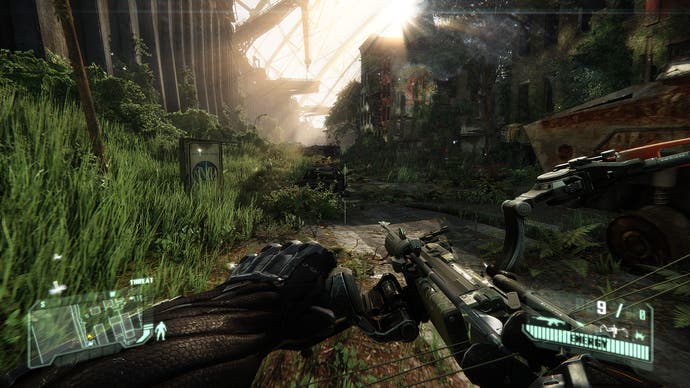
That's a tantalising kind of choice, but it's worth remembering that the first two Crysis games - by which I mean Crysis 1 and Warhead - used to support several different styles of gameplay just as confidently as Crysis 3 now supports stealth. While the latest instalment renders the sneaking and hunting more enjoyable than ever, it struggles to make moments of all-out conflict as entertaining. It's functional when played as a straight shooter, but put the bow aside and try to up the pace and you'll find yourself confronted by unmemorable weapons and lacklustre set-pieces. Rush in guns blazing and you can race through the campaign in just under five hours - and you probably won't remember much of it afterwards.
As a traditional FPS, Crysis 3 has all the usual suspects: vehicle sections, turret moments, an on-rails bit in a chopper and a boss or two. Without the lurking, the waiting, the counting your arrows, it could be almost any other half-decent shooter. Length-wise it feels comparable to Warhead, but that's a comparison Crytek should be wary of encouraging. Despite the return of Psycho as a gruff, Statham-esque presence, it has little of the earlier game's zing as the encounters grow in scale - and even die-hard stealth fans don't get a clear run through to the end.
The final chapters of Crysis 3 lean more heavily towards open conflict with Prophet dashing at full pelt between scattered hotspots. The game simply isn't playing to its strengths here as you learn to rely on maximum armour more than maximum stealth. It's not as much fun when the man in your sights can see the arrow coming.
Crysis 2 decided to spin a yarn in which one of the central characters was an item of clothing; Crysis 3 does not represent a significant improvement.
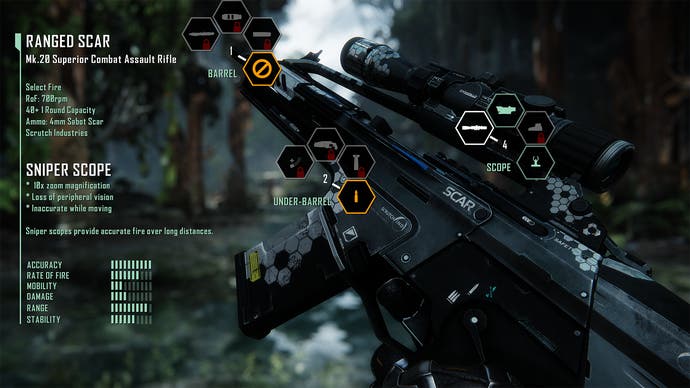
The last level in particular is linear, murky and entirely forgettable. Most irritatingly, that seems to be because it's a hostage of the story and needs to offer a suitably grandiose conclusion. Crysis's end-of-the-world narrative is no worse than that of a dozen other games, but it's no better either, and it's definitely not worth sacrificing those tactical sandboxes in order to herd everyone across the finish line. Crysis 2 decided to spin a yarn in which one of the central characters was an item of clothing; Crysis 3 does not represent a significant improvement.
It's a pretty yarn, at least, with plenty of swaying ferns and shimmering tide pools visible whatever your platform. Prettiness goes with the territory here, but Crytek's engine and art teams have still done amazing work. Played on PC it's an absolute dazzler and, even on 360, the game's urban rainforest is a beautiful and organic place, unbothered by the frame-rate issues that popped up towards the end of Crysis 2 and filled with thick foliage to wade through or to just watch for a few seconds as the light shifts and the shadows flock. It's not just detailed, it's really artful: midtown's been turned into teetering spars of land spread across a volcanic beach, while the Financial District's become a burbling tropical grotto that gives way to spooky bayou as night falls. New York is beautiful once more.

Multiplayer benefits from this variety with a dozen maps that invoke everything from mud plains to military installations. They also make use of the bow in a smart new mode called Hunters, in which two players dropped into Nanosuits track a handful of their friends done up as Cell troopers. Each successful kill sees the fallen spawning again on the hunting team, until it's down to the last man and things grow surprisingly tense.
Elsewhere, standards like deathmatch and team deathmatch are joined by super-powered twists on CTF and King of the Hill, and the whole thing unfolds at a hectic pace, brought on by the churn of the maps and a smart class system. It's got the levelling and load-outs of most online shooters, but it retains its own peculiar identity: not necessarily that of Crysis 3's main campaign, but this breezy, knockabout shooting gallery was put together by Crytek UK anyway.
The story's over, then, and the Nanosuit's had what might be its final airing: is this the conclusion the Crysis series deserves? Not quite: that true panoramic freedom is still missing in action, the campaign's rather undernourished as it rushes you into the final act and the fiction feels increasingly forgettable. There are charms here, though, if you boot up the tactical display and stick to the shadows. There's the silent kill in glorious surroundings; there's the swish of an arrow, the creak of a bow.




